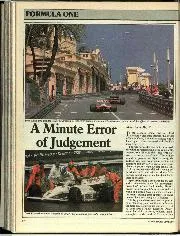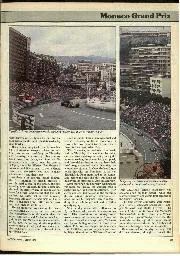“When I had that feeling, I immediately lifted. I said to myself, ‘Today, that is special. Don’t go out any more. You are vulnerable. For whatever reason, you are putting yourself in a situation where you are almost doing it more in a subconscious way.
“I didn’t fully understand that level – and I still don’t.” (Senna was breaking his silence on the matter to Denis Jenkinson of Motor Sport in 1990.)
The race was an epiphany.
Of all the barriers in all the world Senna had to hit that one – within walking distance of the sanctuary of his apartment.
Had it been anyone else, anywhere else, this possibly self-destructive act of the unconscious mind would have been filed benignly but firmly under ‘Blip in Concentration’.
Senna cried away his disappointment as his Portuguese housemaid fielded the inevitable calls.
But also he used that private time to reflect, to try to make sense of it and take decisions on that basis.
These were: he would not talk publically about his transcendental qualifying because, if he didn’t understand, he couldn’t expect others to; and, until he did understand, there was “no need to go in ‘there’ anymore”.
He never did.

Pressure from Prost forced Senna into an error that he wouldn’t make again
DPPI
There were baser realities to be dealt with. Not only had he squandered nine points but also – and most tellingly – he had been panicked by Prost.
Senna had planned to get under the Frenchman’s skin. There was even talk of his attempting to lap him. Yet the reverse happened when Prost, having been bottled for 53 laps behind Gerhard Berger’s Ferrari, uncorked some fast laps.
Senna, though serenely distant, felt compelled to respond.
Senna slowed. Eventually. And, rhythm – or trance – broken, crashed.
This must not be allowed to happen again.
It’s no surprise that Prost, a four-time winner, never again won the Monaco GP.
Why was Senna so good at Monaco?

Senna blasts along the seafront in the 1985 race
DPPI
Being a cynic, I am inclined to believe that that was due mainly to Senna’s apparently superior hand-to-eye co-ordination and seat-of-the-pants feel.
The subtle adaptations of torque generated by his keynote throttle-jabbing technique and the changes in yaw they brought – which no software could model – allowed him a flexibility denied others.
Nowhere was this more obvious than at Monaco.
Senna’s record at Monaco
Year |
Qualifying position |
Finishing position |
| 1984 | 13 | 2 |
| 1985 | 1 | retired (engine) |
| 1986 | 3 | 3 |
| 1987 | 2 | 1 |
| 1988 | 1 | retired (accident) |
| 1989 | 1 | 1 |
| 1990 | 1 | 1 |
| 1991 | 1 | 1 |
| 1992 | 3 | 1 |
| 1993 | 3 | 1 |
Prost was only a match when his set-up was perfect – and Monaco demands too many compromises for mechanical perfection to be attained.
Thus the year’s most glamorous race provided the perfect shop window for Senna to display his gifts, be they God-given or otherwise.
I will happily concede, however, that his experiences at Monaco 1988 made him better. He realised how good he could be – and that even his ‘reasonable’ was far beyond the capabilities of his rivals.
Being the fastest was still what motivated him but, once that had been achieved in qualifying, he could win ‘like Prost’.







